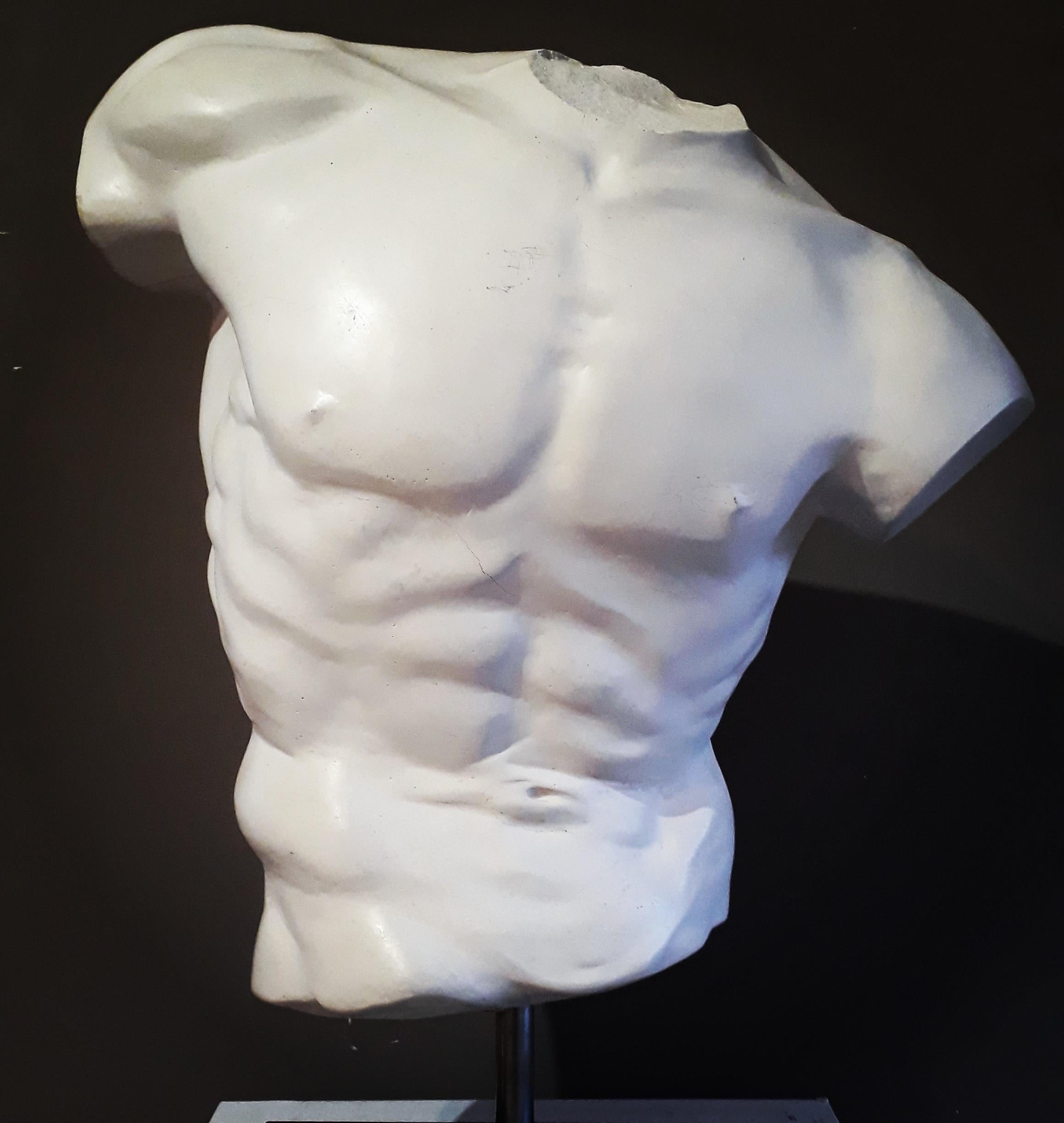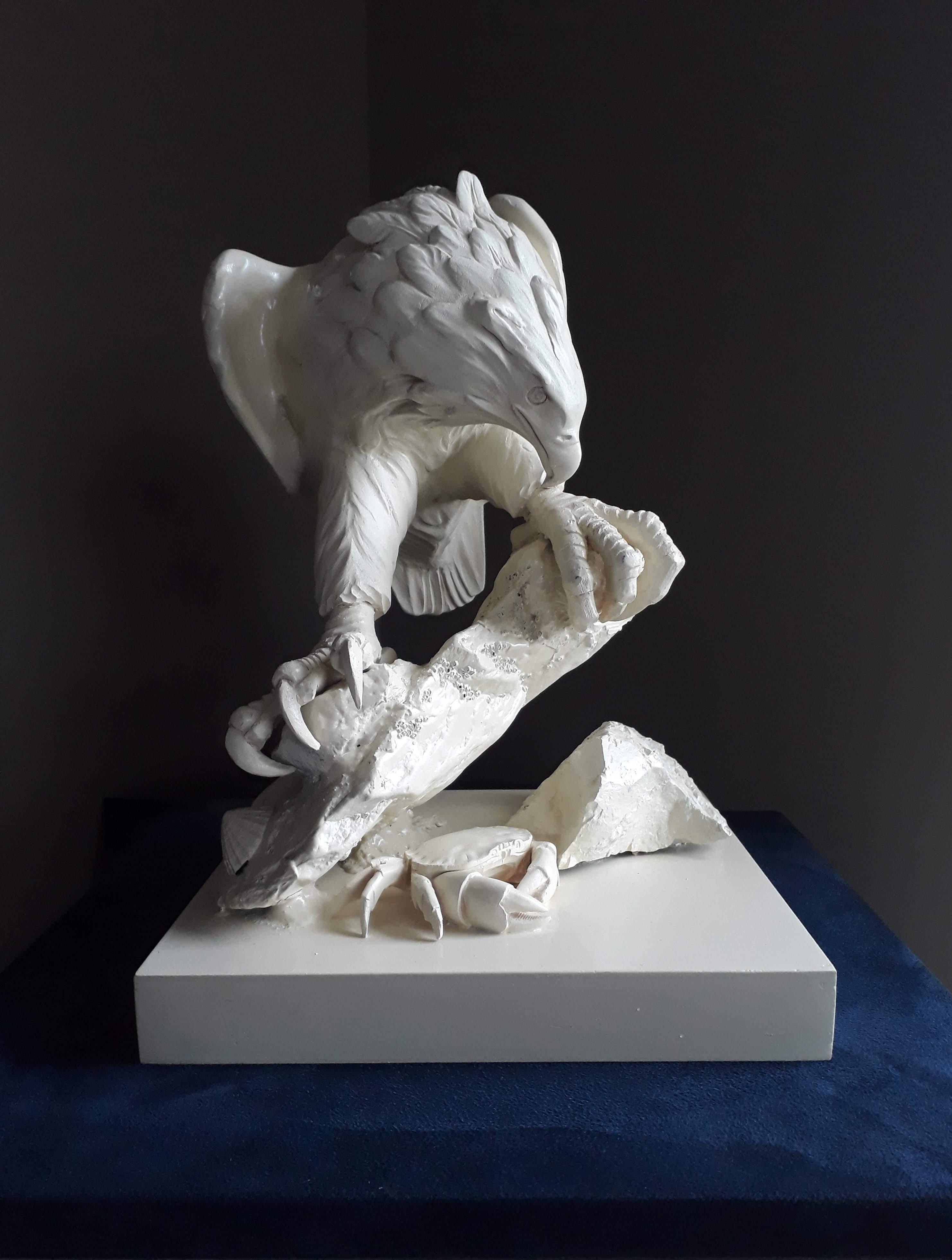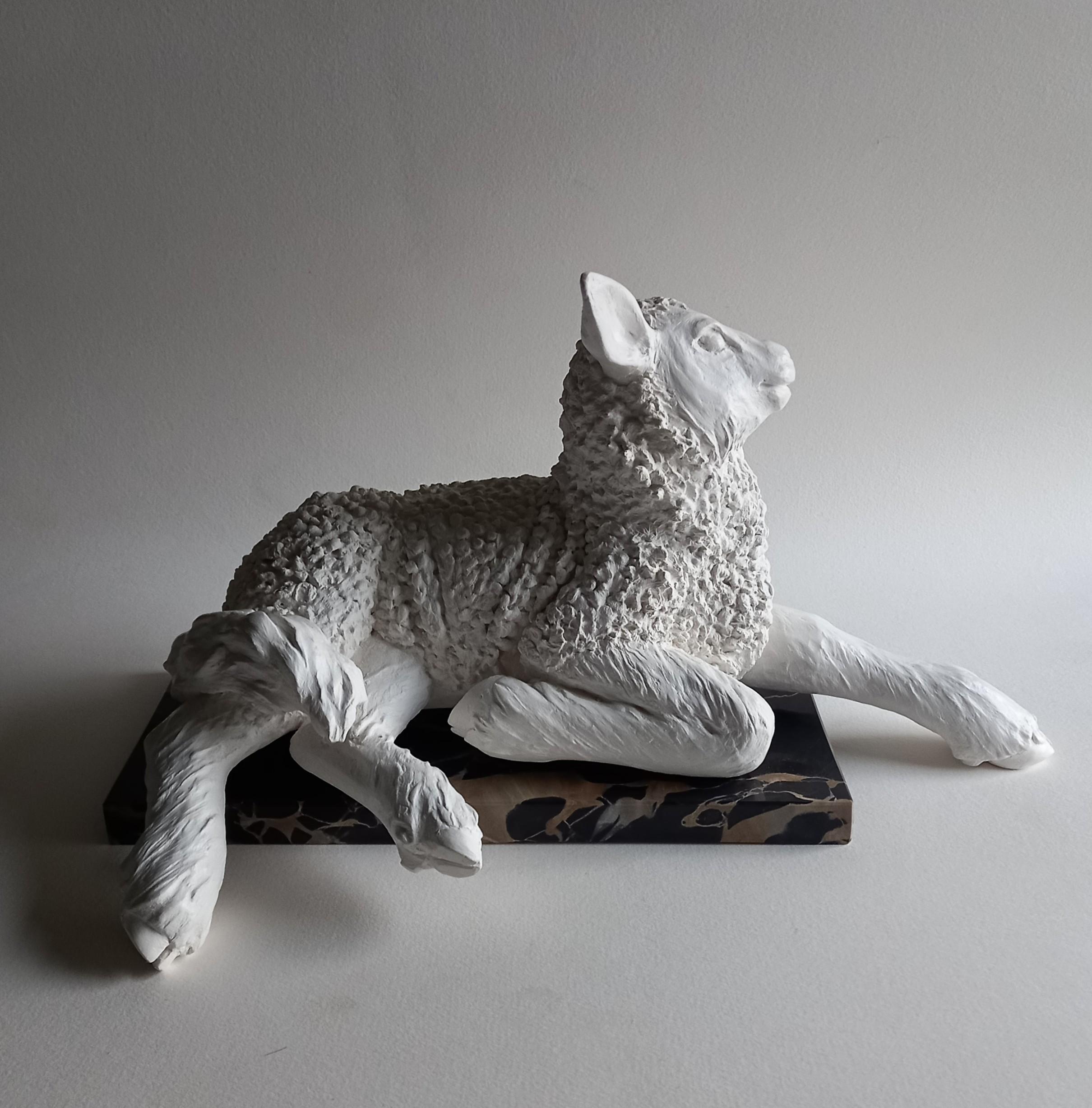Want more images or videos?
Request additional images or videos from the seller
1 of 2
Francisco NarváezMaqueta las toninas1944
1944
About the Item
Maqueta las Toninas, 1944
BMY-022, 1970
Edition 1/25
Bronze
22 x 22 x 10 cm
8.6 x 8.6 x 3.9 in
ABOUT THE ARTIST
Narvaez was born in Porlamar, Venezuela, in 1905; he was the fifth son of eleven siblings; his parents were Jose Lorenzo Narvaez and Vicenta Rivera. Don José Lorenzo, a multifaceted and creative man, sowed the seed of creativity in his son. “My father did not fit in with his fantasies of cabinetmaker, bricklayer, master builder, and self-taught architect.”1 From an early age, Francis was led to the artistic activity, he traced, carved, made replicas of the furniture and the saints restored by his father.
In 1920 he obtained his first professional assignment, a San Rafael for the Church of Carupano, and, in 1922, his father authorized him to travel to Caracas to pursue his studies as an artist. He studied at the atelier of Marcos Castillo, at of the Angel Cabre y Magriña and at the Academy of Fine Arts in Caracas, where he was introduced to the painters and intellectuals of the time.
In 1928 he presented his first solo exhibition at the Club Venezuela. With the money raised from the sale of the works and the support of Monsignor Sosa, and the Ministers Centeno Grau and Arcaya, he studied in Paris on a scholarship. Once there, he enrolled at the Académie Julian, where Tito Salas, Cristóbal Rojas and Arturo Michelena had also studied. It was in Paris where, unable to work in wood, he turned to stone carving. “In Paris, I didn’t have wood, so I carved a lot in stone (…), when there were demolitions I purchased chunks of stone, I would take them to the workshop and carve them.”2
His first attempts at volumetric sculptures and painting in plain colours, linked to the thematic of American miscegenation and Creole reality, can be traced back to that first trip to Paris. During his stay in the French city, Arturo Uslar Pietri, Alfredo Boulton, and Finita Vallenilla supported the artist both financially and logistically, and in February of 1930, the trio of friends arranged another exhibition for him at the Club Venezuela. Narvaez describes his exhibition as follows: “(…) in it I feel that the sculptural work is more my own, done with more assurance, a response to my pursuit of large planes, stylisation and synthesis.”3 By then, as Boulton himself noted in his book about the artist, Narvaez departed from most of the artistic traditions that prevailed by that time in Venezuela.
In 1931 he returned to Caracas and established his atelier at the Barrio Obrero in Catia. The atelier became the hub of the intellectual life of the time. “In those years, the atelier of Francisco Narvaez was the hub of the greatest Venezuelan hope. Nothing comparable to it can be found either before or since.”4
From that year onwards, exhibitions, projects, trips, and awards we multiplied. He was awarded the President of the Republic of Venezuela Prize, the National Sculpture Prize of the 1st Official Venezuelan Art Salon, and the John Boulton Prize of the 3rd Annual Venezuelan Art Salon; for the Military Academy, he produced a spectacular relief entitled La Patria.
In 1945, commissioned by the architect Carlos Raúl Villanueva, he produced two groups of sculptures known as Las Toninas, both located in the O’Leary Square. There, as he himself states, he incorporates some baroque patterns into the figures to the source itself: “It is a work of balance between the decorative requirements and the sculpture of planes and angles.”5
In 1948 he was awarded the National Painting Prize. In the same year, he was called upon by the architect Carlos Raul Villanueva to participate in the project for the arts integration in the Universidad Central de Venezuela. Francisco Narvaez’s public output continued with works such as the statue of Fermín Toro, La Educacion, La Ciencia, three murals (produced by María Luisa Tovar) for the Instituto de Medicina Experimental, El Cristo; el Atleta, the equestrian statue of General Rafael Urdaneta.
In 1953 he was appointed Director of the School of Plastic and Applied Arts, and in July of the same year, he exhibited “Francisco Narvaez, Maderas, Piedras y Bronces” (Francisco Narvaez, Woods, Stones and Bronzes) at the Museum of Fine Arts.
Narvaez is, unquestionably, one of the great Venezuelan sculptors, his work goes through various stages and interests; as the art world evolves, the artist does not remain in his initial scopes of work. His creations are not imposed by the prevailing trends or fashion but do evolve by experimenting with new materials and interests.
When one peruses the artist’s lengthy list of exhibitions, commissions, and awards, it is worth remembering the Narvaez who embark on his career as a child and who, overcoming obstacles, knew how to make the most of his curiosity. He did not settle for living off his successes. He did not remain stagnant as many creators of his environment did. Narvaez managed to understand the changes in the history of art around him. We must not overlook the fact that Francisco Narvaez is an artist amid all the changes occurring in the art world. He moves from the classics to the great transformations in the art world. It is the Europe of Picasso, Braque, Arp. He observes, he is aware of what is happening in the centres of the world of art, but between his craft and his sensitivity, the result is NARVAEZ, his stamp, and his identity.
Francisco Narvaez comes from tradition, and his first stage is linked to the classics, to the exploration of his heritage, but always with his very own language. Throughout his prolific career, he knew how to remain true to himself, without disregarding the influences of his surroundings or his artistic interests: his ability as a sculptor, his selection of materials, whether they were wood, stone or bronze; his choice of the subject of his work…His mastery and great craftsmanship are a constant that over time have made him a leading player in the history of contemporary Venezuelan and world art.
From his beginnings, no subject was foreign to him. His paintings, drawings, aquarelles, and sketches are testimony to his prolific output. Among his themes are portraits, our traditions, still lifes, and landscapes. Narvaez is an artist who represents his time. Later, he evolved towards purer and simpler forms, abandoning figurative art for short periods.
In 1956 he declared to the newspaper El Nacional: “Every day I am freeing myself, it is a soul that frees itself from the ephemeral wrappings of the circumstantial always, as well as from the inevitable weight of the anecdote. This second stage of my work is remarkably close to abstractionism, even if there are still certain figures or figurations in the sculptures that I will shortly be showing. However, pure, and absolute abstractionism, it will treat the form itself as the sole reason for its existence on the plane of artistic excellence.”6
The artistic development was his professional life. Each period of his life as an artist, he went one step further, searching, solving, seeing plenty of things and understanding how diverse expressions were transforming themselves. His hands followed his gaze and his mind, always inquisitive. He added movement to the volumes.
Arturo Uslar Pietri, “Formas Nuevas”, Cromotip editions, 1956 “Francisco Narvaez is a path: the path that Venezuelan sculpture has travelled in the last thirty years. Between the calling of the earth, the obstacles, the circumstances, and the demands of the universal, he has turned his creative effort into a work that, neither in its abundance, nor in its intensity, nor in its significance, has any precedent in our sculpture.”7
He claims to have attained the union between painting and sculpture – The dimension that painting lacked, through stuccoes, first exhibited at the Sala Mendoza in 1962…The stuccoes will also be featured in this exhibition, where they will once again seem more relevant than ever. His subjects include a new social realism, religious and domestic scenes, and historical events. His strokes are increasingly purer and more harmonious. The use of elements, such as wood and stone, are transformed into narratives to the delight of the audience.
Regarding his works in public settings, the artist himself states that in the redevelopment of El Silencio, “due to the demands of the architect Carlos Raul Villanueva, I incorporated certain baroque patterns into the shapes and the fountain itself, emphasising the line in order to connect it with the environmental unit. It is a work of balance between the ornamental requirements and the sculpture of planes and angles.”8
The time goes by, the awards, the exhibitions, and Narvaez never stops astonishing us. The elements are transformed. Sometimes figurative, sometimes abstract, or geometric. In each piece lies his Venezuelan heritage. The roots that tie him to his homeland, but we also find his quests, new visions and his understanding of what is happening in the world.
In short, the artist is rooted in Venezuela, but his vision is global. In 1966, in El Nacional, he declared: “It is not abstract art, because I consider that style to no longer be fashionable. My work is suggestive, because it does not focus on details, but rather stylises the composition (…). The artist cannot confine himself to conformity. (…) He must continue to learn and to live in a permanent search (…). It is worth noting that, in Venezuela, as nowhere else in the world, sculptures are mistreated regardless of the fact that each of these pieces is part of the cultural heritage of the nation (…), there is a lack of education and principles that are binding on everyone, that they do not belong to one individual, but the whole society.”9
1976 is a turning point; he is awarded the Orden Francisco de Miranda First Class. In May, he exhibited at the Arte Contacto Gallery (Caracas, Venezuela) twenty-four pieces entitled “Narvaez Bronces Bruñidos”; In June at the Painting Exhibition of the signatory countries of Andrés Bello Agreement and Panama, organised by the Ministry of Education at the Casa de Bello; in July at the Angel Boscan Gallery of the Department of Culture at the Universidad Central de Venezuela; in September at the Marlborough Gallery in New York, in the United States, with sixteen bronze casts from his last period. This exposition was sponsored by the gallery Arte Contacto and later was sent to Madrid to the Galeria Sen (June 1978). In The same year, he participates in the Second Encounter of Contemporary Artists at Galeries Nationales Gran palais, Paris.
In November, the Museum of Contemporary Art of Caracas held the most ambitious exhibition of the artist’s work. The collection is composed of 141 pieces and has a retrospective approach including all his stages. In 1979, the Museum of Contemporary Art Francisco Narvaez opened its doors in Porlamar, Nueva Esparta State, Venezuela. The artist donated fifty-nine pieces to be permanently exhibited on the premises.
He was a connoisseur of the art world as well as a skilled artist. Narvaez never limited himself in his artistic expressions or his pursuits. His versatility made him one of the greatest Venezuelan sculptors of all time. His ease and confidence, gained after a prolific and creative life, allow us to admire him even more from a distance. One of the most remarkable aspects that we can notice in this great retrospective exhibition held at the Ascaso Gallery in its new location in Miami, is how Francisco Narvaez produces his work with each one of the materials that are familiar to him: stone, wood, bronze; and in every one of the spaces he selected to convey his work: painting, sculpture, drawing. This exhibition not only provides a unique opportunity to experience his entire artistic creation, but it is also a didactic overview of one of Venezuela’s great masters, who had the privilege of producing practically throughout his entire existence.
It is noteworthy, that in the state of Florida, in St. Augustine, we can appreciate a piece of his creation: ‘the Busto of José Maria Vargas’. Which is to be found in the gardens of the oldest wooden school in the United States, located on Saint George Street, specifically in The Grove of Educators of the Americas, and which was donated by the Venezuelan Government in 1948.
Francisco Narvaez deceased on July 7, 1982, leaving a legacy that has remained engraved in the soul of his country and the world.
Adriana Meneses
1Rafael Pineda «Escultura y Pintura de Francisco Narváez», Instituto Nacional de Cultura y Bellas Artes (INCIBA), Caracas, 1968, 10.
2Lydia Pia Flamini de Tomasini, interview, Caracas.
3María Cecilia Valera, interview, Caracas.
4Arturo Uslar Pietri as quoted from the exhibition catalogue «Trayectoria de Francisco Narváez», Museum of Contemporary Art of Caracas, 1976.
5Rafael Pineda «Escultura y Pintura de Francisco Narváez», Instituto Nacional de Cultura y Bellas Artes (INCIBA), Caracas, 1968, 50.
6«El Nacional» newspaper, interview, Caracas, 1956.
7Arturo Uslar Pietri as quoted from the exhibition catalogue «Formas Nuevas», Sala Mendoza, Caracas, 1956.
8Rafael Pineda «Escultura y Pintura de Francisco Narváez», Instituto Nacional de Cultura y Bellas Artes (INCIBA), Caracas, 1968, 50.
9«El Nacional» newspaper, interview, Caracas, 1966.
- Creator:Francisco Narváez (1905 - 1982, Venezuelan)
- Creation Year:1944
- Dimensions:Height: 8.6 in (21.85 cm)Width: 8.6 in (21.85 cm)Depth: 3.9 in (9.91 cm)
- Medium:
- Movement & Style:
- Period:
- Condition:
- Gallery Location:Miami, FL
- Reference Number:1stDibs: LU1613212738162
About the Seller
5.0
Vetted Seller
These experienced sellers undergo a comprehensive evaluation by our team of in-house experts.
Established in 1989
1stDibs seller since 2021
Typical response time: 1 to 2 days
- ShippingRetrieving quote...Ships From: Miami, FL
- Return PolicyA return for this item may be initiated within 14 days of delivery.
More From This SellerView All
- Agustín Cárdenas, El Violinista, Bronze, Edition 4/6, 1983, Small sizeBy Agustín CárdenasLocated in Miami, FLAgustín Cárdenas El Violinista, 1989 Bronze. Ed. 4/6 54 x 36 x 22 cm 21.2 x 14.1 x 8.6 in. AGUSTIN CARDENAS (b. 1927, Matanzas, Cuba; d. 2001 Havana,...Category
1980s Futurist Figurative Sculptures
MaterialsBronze
- Jorge Seguí, Esperansilla, Bronze, Edition 1/7, 2003By Jorge SeguíLocated in Miami, FLJorge Seguí Esperansilla, 2003 Bronze, Edition 1/7 + 3AP 71.1 x 40.6 x 30.4 cm 28 x 16 x 12 in. Signed and Numbered. Jorge Seguí b. 1945, Argentina. He a...Category
Early 2000s Contemporary Figurative Sculptures
MaterialsBronze
- Cornelis Zitman, Divertimiento, 1973, Bronze, 72 x 34 x 45 cmLocated in Miami, FLCornelis Zitman Divertimiento, 1973 Bronze, AP 72 x 34 x 45 cm 28.3 x 13.3 x 17.7 in. Cornelis Zitman (1926-2016) Born in Leiden in a family of builders, he enters the Fine Arts ...Category
1970s Figurative Sculptures
MaterialsBronze
- Agustín Cárdenas, Le Repos Passionné, 1989, Bronze. Edition 7/7By Agustín CárdenasLocated in Miami, FLAgustín Cárdenas Le Repos Passionné, 1989 Bronze. Ed. 7/7 60 x 145 x 51.5 cm 23.6 x 57 x 20.2 in. The artwork is accompanied by a certificate of aut...Category
1980s Futurist Figurative Sculptures
MaterialsBronze
- Jorge Seguí, Falsos Heroes en Caballos Míticos, Bronze, Edition 1/7, 2010-2013By Jorge SeguíLocated in Miami, FLJorge Seguí Falsos Heroes en Caballos Míticos, 2010-13 Bronze, Edition 1/7 110 x 71 x 70 cm 43.3 x 27.9 x 27.5 in. Signed and Numbered. Jorge Seguí b. 19...Category
2010s Contemporary Figurative Sculptures
MaterialsBronze
- Version sobre un caballo de tropa mongol No 4. sin cresta, Edition 6/8By Alirio PalaciosLocated in Miami, FLVersion sobre un caballo de tropa mongol No 4. sin cresta, 2013 Edition 6/8 Bronze 52 x 74 x 19 cm 20.4 x 29.1 x 7.4 in About The Artist Alirio Palacios (1928-2015) was one of the ...Category
2010s Figurative Sculptures
MaterialsBronze
You May Also Like
- 19th Century French Bacchanalian BronzeLocated in San Antonio, TX19th Century French Bacchanalian Bronze in the 18th century style depicting two Putti, in the manner of Clodion. One putto reclines while another feeds it grapes. The Patina is worn ...Category
Late 19th Century Baroque Figurative Sculptures
MaterialsBronze
- Perseus and Fame proclaiming the birth of PegasusLocated in Oswestry, GBThis neo-classical style sculpture is of Perseus the son of Zues and Danae is ordered by King Polydectes to slay the gorgon Medusa. With the gift of a polished shield from Athena, a ...Category
Early 17th Century Baroque Figurative Sculptures
MaterialsBronze
- Discus Thrower's TorsoLocated in Oswestry, GBThis artwork emulates the classical statues from the ancient world, particularly with the head broken off at the base of the neck if carved in marble. In fact I went to the lengths o...Category
17th Century Baroque Figurative Sculptures
MaterialsGranite, Bronze
- White tailed sea eagle and crabLocated in Oswestry, GBThis white tailed sea eagle is depicted here on a rock on the shore of a remote wild Scottish Isle (Outer Hebrides). Hiding beneath the rock is a brown crab...Category
16th Century Baroque Figurative Sculptures
MaterialsBronze
- LambLocated in Oswestry, GBThis lamb is also featured in my statue of Saint David. It conveys such character and gentleness that I decided to present it as a sculpture in its own right. I lays on a base of bla...Category
2010s Baroque Figurative Sculptures
MaterialsMarble, Bronze
- GreyhoundLocated in Oswestry, GBWhat is unique about this artwork is the grace and elegance of the greyhound but designed in a most difficult stance frought with technical challenges. Yet the result offers a stance...Category
Early 17th Century Baroque Figurative Sculptures
MaterialsBronze





